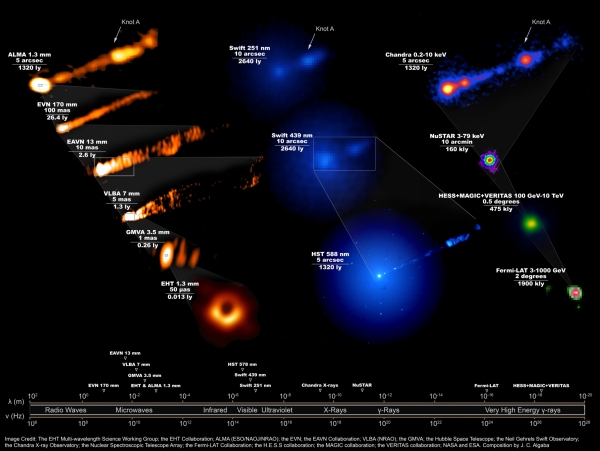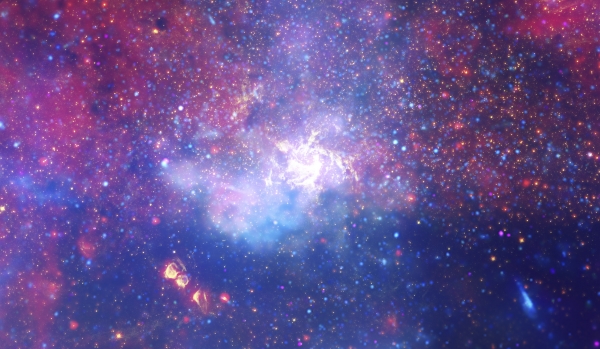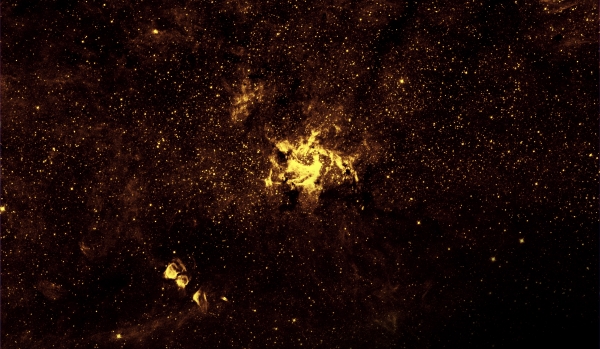Only time will tell whether humanity has a future beyond the Solar System, but if we do have prospects among the stars — and I fervently hope that we do — it’s interesting to speculate on what future historians will consider the beginning of the interstellar era. Teasing out origins is tricky. You could label the first crossing of the heliopause by a functioning probe (Voyager 1) as a beginning, but neither the Voyagers nor the Pioneers (nor, for that matter, New Horizons) were built as interstellar missions.
I’m going to play the ‘future history’ game by offering my own candidate. I think the image of the black hole in the galaxy M87 marks the beginning of an era, one in which our culture begins to look more and more at the universe beyond the Solar System. I say that not because of what we found at M87, remarkable as it was, but because of the instrument used. The creation of a telescope that, through interferometry, can create an aperture the size of our planet speaks volumes about what a small species can accomplish. An entire planet is looking into the cosmos.
So will some future historian look back on the M87 detection as the beginning of the ‘interstellar era’? No one can know, but from the standpoint of symbolism — and that’s what this defining of eras is all about — the creation of a telescope like this is a civilizational accomplishment. I think its cultural significance will only grow with time.

Image: Composite image showing how the M87 system looked, across the entire electromagnetic spectrum, during the Event Horizon Telescope’s April 2017 campaign to take the iconic first image of a black hole. Requiring 19 different facilities on the Earth and in space, this image reveals the enormous scales spanned by the black hole and its forward-pointing jet, launched just outside the event horizon and spanning the entire galaxy. Credit: the EHT Multi-Wavelength Science Working Group; the EHT Collaboration; ALMA (ESO/NAOJ/NRAO); the EVN; the EAVN Collaboration; VLBA (NRAO); the GMVA; the Hubble Space Telescope, the Neil Gehrels Swift Observatory; the Chandra X-ray Observatory; the Nuclear Spectroscopic Telescope Array; the Fermi-LAT Collaboration; the H.E.S.S. collaboration; the MAGIC collaboration; the VERITAS collaboration; NASA and ESA. Composition by J.C. Algaba.
Into the Milky Way’s Heart
The Event Horizon Telescope (EHT) is not a single physical installation but a collection of telescopes around the world that use Very Long Baseline Interferometry to produce a virtual observatory with, as mentioned above, an aperture the size of our planet. Heino Falcke’s book Light in the Darkness (HarperOne, 2021) tells this story from the inside, and it’s as exhilarating an account of scientific research as any I’ve read.
M87 seemed in some ways an ideal target, with a black hole thought to mass well over 6 billion times more than the Sun. In terms of sheer size, M87 dwarfed estimates of the Milky Way’s supermassive black hole (Sgr A*), which weighs in at 4.3 million solar masses, but it’s also 2,000 times farther away. Even so, it was the better target, for M87 was well off the galactic plane, whereas astronomers hoping to study the Milky Way’s black hole have to contend with shrouds of gas and dust and the fact that, while average quasars consume one sun per year, Sgr A* pulls in 106 times less.
But the investigation of Sgr A* continues as new technologies come into play, with the James Webb Space Telescope now awaiting launch in December and already on the scene in French Guiana. Early in JWST’s observing regime, Sgr A* is to be probed at infrared wavelengths, adding the new space-based observatory to the existing Event Horizon Telescope. Farhad Yusef-Zadeh, principal investigator on the Webb Sgr A* program, points out that JWST will allow data capture at two different wavelengths simultaneously and continuously, further enhancing the EHT’s powers.
Among other reasons, a compelling driver for looking hard at Sgr A* is the fact that it produces flares in the dust and gas surrounding it. Yusef-Zadeh (Northwestern University) notes that the Milky Way’s supermassive black hole is the only one yet observed with this kind of flare activity, which makes it more difficult to image the black hole but also adds considerably to the scientific interest of the investigation. The flares are thought to be the result of particles accelerating around the object, but details of the mechanism of light emission here are not well understood.

Image: An enormous swirling vortex of hot gas glows with infrared light, marking the approximate location of the supermassive black hole at the heart of our Milky Way galaxy. This multiwavelength composite image includes near-infrared light captured by NASA’s Hubble Space Telescope, and was the sharpest infrared image ever made of the galactic center region when it was released in 2009. While the black hole itself does not emit light and so cannot be detected by a telescope, the EHT team is working to capture it by getting a clear image of the hot glowing gas and dust directly surrounding it. Credit: NASA, ESA, SSC, CXC, STS.
Thus we combine radio data from the Event Horizon Telescope with JWST’s infrared data. How different wavelengths can tease out more information is evident in the image above. Here we have a composite showing Hubble near-infrared observations in yellow, and deeper infrared observations from the Spitzer Space Telescope in red, while light detected by the Chandra X-Ray Observatory appears in blue and violet. Flare detection and better imagery of the region as enabled by adding JWST to the EHT mix, which will include X-ray and other observatories, should make for the most detailed look at Sgr A* that has ever been attempted.
What light we detect associated with a black hole is from the accreting material surrounding it, with the event horizon being its inner edge — this is what we saw in the famous M87 image. The early JWST observations, expected in its first year of operation, are to be supplemented by further work to build up our knowledge of the flare activity and enhance our understanding of how Sgr A* differs from other supermassive black holes.

Image: Heated gas swirls around the region of the Milky Way galaxy’s supermassive black hole, illuminated in near-infrared light captured by NASA’s Hubble Space Telescope. Released in 2009 to celebrate the International Year of Astronomy, this was the sharpest infrared image ever made of the galactic center region. NASA’s upcoming James Webb Space Telescope, scheduled to launch in December 2021, will continue this research, pairing Hubble-strength resolution with even more infrared-detecting capability. Of particular interest for astronomers will be Webb’s observations of flares in the area, which have not been observed around any other supermassive black hole and the cause of which is unknown. The flares have complicated the Event Horizon Telescope (EHT) collaboration’s quest to capture an image of the area immediately surrounding the black hole, and Webb’s infrared data is expected to help greatly in producing a clean image. Credit: NASA, ESA, STScI, Q. Daniel Wang (UMass).
Whether we’re entering an interstellar era or not, we’re going to be learning a lot more about the heart of the Milky Way, assuming we can get JWST aloft. How many hopes and plans ride on that Ariane 5!



The interstellar era will begin when WE go interstellar, instead of simply observing.
“The interstellar era will begin when WE go interstellar”: indeed. For selected values of “WE”.
For meat robots (=Homo sapiens and its derivatives/descendants). past the Van Allen belts, solar radiation and further afield cosmic radiation will slow cook them sans shielding, passive or active. Meatless robots may fare better.
When I say “we” I mean “we”, not others.
Well put. If we build interstellar travelling artilects that explore for we meat humans, does that count as part of the “we” or not?
I would argue that however we go to the stars, that counts as we/humanity. If those robots are human-level intelligent (or better), that makes them more akin to our descendants, IMO.
Agreed: artilects “more akin to our descendants” “manning” an interstellar (meatless) obsurvatory will count as humans, even if no more meat humans travel beyond the low earth orbit of the international space station.
That observing could delay interstellar travel considering that it might be cheaper to build a large space telescope even larger than the JWST, than make an interstellar spacecraft. Also there is the idea that in the future and newer more faster and efficient propulsion technology will allow the older rocket to be overtaken by the newer one.
The flares are most likely the result of the heat caused by the friction of particles as they are accelerated faster as they move closer to the black hole and there is a collision of the faster moving particles of dust and gas with the slower ones as already noted in this paper.
From quite some years ago I’m missing in this field more practical thinking and more ambition, less theorizing and less observing. For example, instead of computing trajectories to Oumuamua with no aim to implement them, better spend that time and effort developing some interstellar technology, even at very small steps, like solar sails, magnetic sails, fusion (yeah, tomakaks are expensive and developed by big organizations, but there are other approaches that need much less money now and are more adequate for space travel, like the sheared flow stabilized z-pinch), …
It’s like SETI. Some decades ago the mainstream decided to abandon METI, and since then it’s only “listening” and more “listening” and no “speaking”.
Oh but Geoffrey if we could have a number of advanced telescopes sent in different directions to the Sun’s gravitational focal point, each of course in such a direction that it could observe a particular star of interest when looking back at the Sun, they could also serve as a EHT with a 1000AU baseline.
And the technologies developed to get them to 500AU in a reasonable time will certainly advance our efforts to send missions further out. These telescopes themselves will not stop at 500AU just for the focal point mission, they will already be doing VLB Interferometry while on their way there, and continue to do so with an ever increasing baseline.
I think building telescopes will boost interstellar exploration rather than delay it.
Whenever I see such stunning images and what knowledge can be inferred from the measurements, I find myself thinking how much the instruments and technology we have has improved over the last century. Look at any popular astronomy book written no later than the middle of the 20th century (e.g. The Milky Way, by B Bok and P Bok, 1957), and our understanding of stars and our galaxy was almost nothing in comparison. We knew our galaxy was a spiral type, and that it was just one of many in the universe. But apart from nice photographic plates of stars and nebulae captured in visible light (radio astronomy was still young, and x-ray and gamma ray astronomy not even possible inside the atmosphere), we had no idea what was lurking in the heart of our galaxy, nor the movements of all but the fastest stars. I recall the first measurements of the cosmic background temperature yet now we have detailed maps of this. As new instruments bring ever more power to our understanding of the universe grows, every significant advance just seems to delight. May it never end.
Given the vagaries of commitment being made by the big polluters at the current Cop26, we’ll be lucky if we have a functioning planet from which to make our interstellar journey. Plasma fusion technology for both planetary energy and extra- planetary, needs now to be given the same global prioritisation as covid and any other of the multiple threats against humanity. Put simply, we need to get our act together soon if we are going to move from naval gazing to more than just gazing into the cosmos. Just a thought!
The economic destruction and loss of life due to global heating is going to make WWII and the cost of “forever wars” seem like warm up exercises by comparison. If we need a much large economy to support developing a solar system wide economy, let alone an interstellar exploration one, we really need to avert this scenario as much as possible, given that further heating is “baked in” and will occur even if we achieve net zero tomorrow.
An impoverished world will make the planetary exploration disappointments we have today perversely seem like a golden age of exploration. Maybe we are in a race to achieve our scientific and technological goals before a new age of retrenchment occurs, much like the end of the Western Roman empire. It seems almost fitting that Apple tv+ is running its “Foundation” miniseries. Climate scientists are the Cassandras represented by Hari Seldon. Only there is no Foundation equivalent to speed up the end of the interregnum.
The answer:
https://assets.amuniversal.com/59803ca018b0013a814a005056a9545d
The best candidates for a solar foci mission would start with our galactic core…then Gilese 7IO. Barnard’s Star too fast most likely.